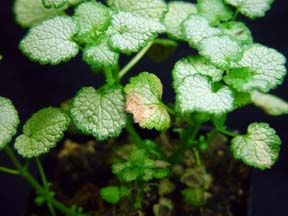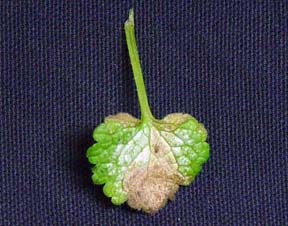Control of downy mildew in Lamium
Editor’s note: This article is from the archives of the MSU Crop Advisory Team Alerts. Check the label of any pesticide referenced to ensure your use is included.
In 2008, a trial was funded by IR-4 to examine the effect of some novel fungicides on downy mildew in Lamium. The following report is a summary of the findings. Some of the treatments were experimental and have been left out of the report, as they are not yet registered.
Many oomycetes impact the perennial plant industry and their occurrence, impact and difficulty to control continues to be a problem. The oomycetes include Pythium, Phytophthora and Peronosporales species. Traditionally, these pathogens have been successfully controlled through the use of the systemic fungicide metalaxyl. However, since its introduction in the early 1980s in Europe, many pathogen populations have been identified that are resistant to or have reduced sensitivity to metalaxyl/mefenoxam-based products.
Resistance to metalaxyl/mefenoxam is a common phenomenon in agriculture but has not been widely reported or tested in the perennial industry, in part due to the more intensive use of metalaxyl/mefenoxam-based products in agriculture. However, in vegetable crops, metalaxyl/mefenoxam resistance has been reported in potatoes (P. infestans ; late blight, Pythium ultimum; P. erythroseptica; pink rot); cucurbits and peppers (P. capsici) and grapes (Plasmopara viticola). There has been much research on metalaxyl/mefenoxam resistance; however data are sparse on metalaxyl/mefenoxam resistance management in perennials.
In the perennial plant industry in Michigan, oomycetes are controlled primarily by cultural practices such as water management and pathogen exclusion on seed stock, but primarily fungicides are the main protection measure. The use of some conventional fungicides alone to control these problems is expensive, and frequent usage may hasten the development of resistance. Failure of control of some oomycetes has already been noted in Michigan (e.g. downy mildew in Rudbeckia and a reduction in control in Lamium). Although perennials such as Rudbeckia are a high value crop, production costs are also high. This provides incentive for growers to look for alternative means of managing diseases, while maintaining the quality of their plant material and controlling costs. The use of low risk directed action fungicides could greatly reduce the reliance on conventional fungicides, and reduce costs associated with the necessity for more frequent or higher rates of pesticide applications. These types of products allow for a reduction in the use of traditional chemical fungicides, and reduce costs to the grower and environment and may provide efficient and cost effective alternatives to metalaxyl/mefenoxam-based-products.
Cultural practices such as water management and pathogen exclusion on seed stock are a portion of the IPM regime for controlling oomycete pathogens, but conventional fungicides are currently the primary means of protection. New reduced risk fungicides need to be evaluated against pathogens of minor crops prior to adoption as part of an IPM program. This project will evaluate the use of reduced risk fungicides to determine suitable alternatives for conventional metalaxyl/mefenoxam-based-products. Although controlling production costs and maintaining product quality are major issues in fostering grower acceptance and adoption of reduced risk fungicides, there is also the issue of risk. Growers must avoid crop failure and are intimidated by novel products and approaches. Through proposals such as this, the university provides a pre-screening process and works out the details for successful product use, thereby reducing perceived risks associated with adoption of reduced risk fungicides by the grower.
The project was conducted on the ornamental crop Lamium maculatum (Silver Beacon) with plants provided by Raker’s Acres Inc., Michigan. A randomized complete block design was used. The plot size was 14 treatments by 4 replications with 20 plants/plot per replication (some treatments left out of this report). Standard statistical analyses, ANOVA was used to analyze the data. One location was used, MSU’s Clarksville Horticultural Research Farm. Plants were treated during July and August as described in Table 1. Plants were produced from seed at Raker’s Acres then transplanted by hand on June 6, 2008.
Plants were situated in rows 12-inch apart within two rows (36 inches apart). The soil was a clay/loam. Applications were made on June 27, and July 5, 12 and 19 as required. All fungicides in this trial were applied on a seven or 14-day interval from June 27 to July 18 with handheld R&D spray boom calibrated to deliver 25 gal/A (80 p.s.i.) using three XR11003VS nozzles per row. Weeds were controlled by cultivation and with Dual 8E (2 pt/A on July 11). Plots were rated visually for percentage foliar area affected by downy mildew on September 10 and October 14 [92 and 109 Days after planting (DAP)].
Downy mildew index was calculated as percent of leaves and stems with lesions. Downy mildew was evaluated 54 and 88 days after the final application of treatments. The average index for each evaluation was expressed as a function of time after planting. Plant vigor was also measured at the above dates where 100 percent represented the most vigorous plants in the trial. Plants (n = 30) already affected by Perenospora lamii were grown in a humid environment in a greenhouse and watered frequently overhead to encourage disease development. The plants were transferred to the inoculated plots on July 31 and placed at random within the experimental area. The entire trial area was irrigated with supplemental water by an overhead irrigation system designed to supply about 3 cm ha-1 per application. The system was on a timer and was initiated at 13:00 each day for the duration of the experiment. The project was carried out inside greenhouses at MSU (to produce infected plant material) and the trials were conducted at MSU’s Clarksville Horticultural Research Farm.
Results and discussion
Downy mildew developed slowly in the trial due in part to a long dry period during the experiment despite the supplemental irrigation. All treatments significantly reduced downy mildew in comparison to the untreated control at both evaluation dates. The most effective treatment was V-10161 2SC (2 fl oz/100 gal) although it was not significantly different from treatments with less than an average of 2.3 percent foliar downy mildew. In terms of plant vigor, treatments with greater than 73.8 percent vigor scores had significantly higher vigor than the untreated control 54 days after the final fungicide application (DAFA). All treatments had significantly higher vigor than the untreated control 88 DAFA. No phytotoxicity was observed in the trial.
Table 1. Efficacy of fungicides on downy mildew of Lamium
| Treatment and Rate of application | Downy Mildew (%)z | Plant vigory | ||||||
| 92 DAPx(54 DAFAw) | 126 DAP(88 DAFA) | 92 DAP(54 DAFA) | 126 DAP(88 DAFA) | |||||
| Heritage 50WDG 4 oz/100 gal +Induce SL 0.125% v/v (A,B,C,Dv) | 0.3 | bu | 0.5 | cd | 77.5 | de | 77.5 | bc |
| Heritage 50WDG 4 oz/100 gal +Induce SL 0.125% v/v (A,C) | 0.3 | b | 1.5 | bcd | 77.5 | de | 80 | bc |
| Insignia 20WG 4 oz/100 gal (A,C) | 0.3 | b | 2 | bcd | 90 | ab | 93.8 | a |
| Insignia 20WG 8 oz/100 gal(A,C) | 0.3 | b | 0.8 | bcd | 87.5 | abc | 95 | a |
| Pageant 38WG 6 oz/100 gal (A,B,C,D) | 0.5 | b | 1 | bcd | 95 | a | 95 | a |
| Pageant 38WG 12 oz/100 gal (A,B,C,D) | 0.8 | b | 2 | bcd | 95 | a | 97.5 | a |
| Allude 45.8SC 64 fl oz/100 gal (A,C) | 0.8 | b | 2.8 | b | 72.5 | ef | 75 | c |
| Stature 50WG 12.3 oz/100 gal (A,C) | 0.5 | b | 2 | bcd | 77.5 | de | 77.5 | bc |
| Subdue Maxx 21.3SC 1 fl oz/100 gal (A,C) | 0.5 | b | 1.5 | bcd | 75 | def | 77.5 | bc |
| Untreated control | 5.8 | a | 11.3 | a | 67.5 | f | 61.3 | d |
z Percentage of foliage affected by downy mildew (Perenospora lamii).
y Plant vigor where 100% represents the most vigorous plants in the trial.
x Days after planting.
w Days after final application of fungicide.
v Application dates: A= 27 Jun; B= 5 Jul; C= 12 Jul; D= 19 Jul.
u Values followed by the same letter are not significantly different at p = 0.05 (Tukey Multiple Comparison).

Downy mildew on Lamium plants.

Downy mildew on Lamium leaf.
Dr. Kirk's work is funded in part by MSU's AgBioResearch.



 Print
Print Email
Email


